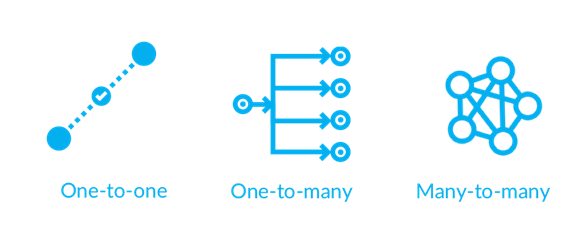If you ask five different people “How would you define the Internet of Things?”, you will probably get five different answers! The term has generated a lot of buzz in the media in the past few years. You may see this as an unjustified hype, but one thing that’s for sure a reality: all sorts of new devices around us are getting connected each and every day, and in almost all of these cases, it is wireless connectivity that’s getting integrated into these devices.
When it comes to wireless connectivity, there are quite a few different technologies available to an IoT developer. Some of these have been around for a long time (e.g. Wi-Fi, Bluetooth, and ZigBee) and some are relatively new (e.g. LoRaWAN, SigFox, NB-IoT, and LTE-M). Of course, there’s no one-size-fits-all when it comes to choosing a wireless technology for your product, so it’s important to know the advantages and limitations of each technology at the time of design.
In the past few years, cellular IoT technologies such as LTE-M, NB-IoT, and 5G have gained a lot of media attention, and this is for good reason. The promise of ubiquitous 5G connectivity and the release of game-changing NB-IoT and LTE-M solutions such Nordic’s nRF9160 chipset open up opportunities for use cases that were not possible before.
Bluetooth, on the other hand, has been around for many years and has gone through quite a few updates and has adapted well to the needs of the market. For example, Bluetooth Low Energy (BLE) was introduced in 2010 and has become the go-to solution for wearables and personal fitness devices.
History of Bluetooth
In December 2016, the Bluetooth Special Interest Group (SIG) released version 5.0 of the Bluetooth specification which introduced two new modes: long-range (Coded PHY) and high-speed (2M PHY). This release allowed Bluetooth to be used in more use cases such as short-range high-speed transfer and long-range remote-control applications. In January 2019, the SIG introduced yet another version (5.1) of the Bluetooth specification which made it possible to use Bluetooth for direction finding applications.
One unique specification, which was released by the SIG in July 2017, is the Bluetooth mesh specification. What makes this release unique is that it’s the first whole specification that’s separate from the core Bluetooth specification and that focuses on an application-level implementation of the technology (specifically Bluetooth Low Energy).
The feature that BLE lacked since the beginning was the capability of supporting a many-to-many topology (often referred to as mesh), where multiple BLE devices can send each other messages and relay messages to other devices within a network. Bluetooth changed this by introducing the capability of many-to-many device communication in the Bluetooth mesh specification.

Other low-power wireless technologies such as Z-Wave and Zigbee have supported the mesh topology for many years, so it’s only natural for Bluetooth to adapt and provide this capability. The major applications that benefit from mesh topologies are home automation, building automation, and industrial applications.
With the introduction of Bluetooth mesh, Bluetooth can now target these applications and provide another option for IoT solution manufacturers. It was built from the ground up to support thousands of devices to participate within the network. This fact in addition to the security measures supported by the specification make it ideal for commercial-grade mesh network deployments.
Technical facts of Bluetooth mesh
We won’t dive deep into the technical details of Bluetooth mesh here – we’ll leave that to another post. Instead, we’ll just list some of the most important technical facts about the protocol.
- Bluetooth mesh builds upon Bluetooth Low Energy and utilizes many of the features of BLE, particularly advertising and scanning.
- Bluetooth mesh supports all versions of BLE (going back to Bluetooth version 4.0, which is the first version of the Bluetooth specification that included BLE).
- The Bluetooth mesh specification is divided into three parts:
- Mesh Profile Specification: which defines fundamental requirements to enable an interoperable mesh networking solution for Bluetooth LE wireless technology
- Mesh Model Specification: which introduces models, used to define basic functionality of nodes on a mesh network.
- Mesh Device Properties: which defines device properties required for the Mesh Model specification.
- Bluetooth mesh mandates industrial-grade security, including 256-bit elliptic curves and AES-CCM using 128-bit keys.
- Bluetooth mesh provides global interoperability since it’s based on BLE (which itself is global).
- Bluetooth mesh utilizes what’s referred to as a managed flooding technique for propagating messages throughout the network.
- Managed flooding is differentiated from simple flooding by introducing the capability for the original message transmitter to specify the maximum number of hops a message is allowed to take within the network.
- The maximum hops a message can travel within a Bluetooth mesh network is 127 hops.
- The maximum number of nodes within a Bluetooth mesh network is 32,767 nodes.
Summary & Closing
In this post we gave a background view of Bluetooth mesh and went over some of the most important technical facts of Bluetooth mesh. We barely scratched the surface and there’s so much to cover that would go beyond a reasonable length post!
To learn more about the Bluetooth mesh standard, check out the official specification documents which can be found here:
https://bluetooth.com/specifications/mesh-specifications/
Once you’re ready to take your knowledge into practice, the next step would be to learn how to implement a Bluetooth mesh on a real development platform such as the Nordic nRF52 series chipsets. This page provides a good starting point:
https://www.nordicsemi.com/Products/Low-power-short-range-wireless/Bluetooth-mesh

